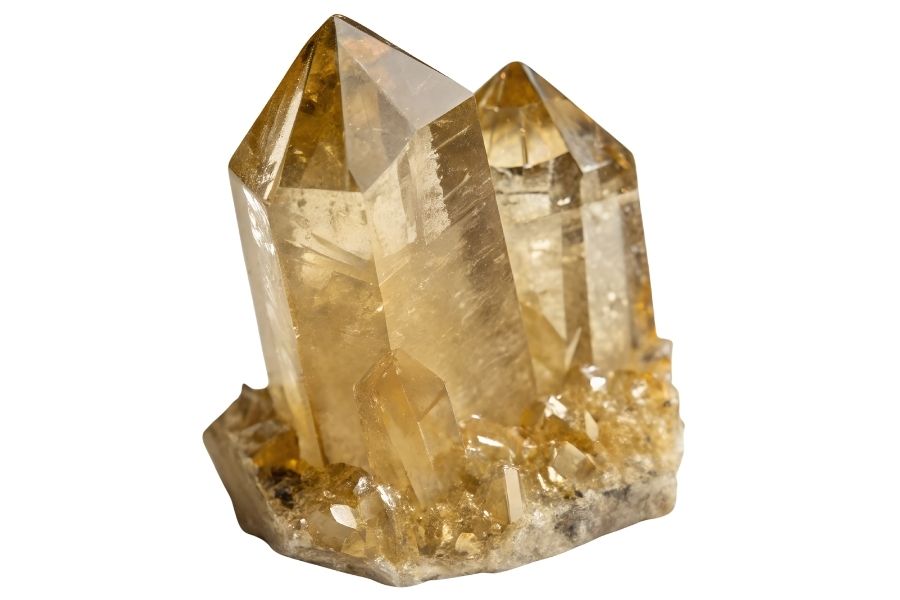Whether you’re a beginner or an experienced rockhound there are some great options for gem mining in Wisconsin. From the Baraboo Hills to the Kettle Moraine, these locations are filled with beautiful gems.
Wisconsin is a great spot for finding gems, especially in the northwestern and southwestern regions. Stream beds, river gravels, quarries, glacial moraine gravels, and lakeshore beaches are all great places to look for rocks. Mining dumps are also a great source of specimens, with a high probability of finding something.
In this article, we’ll be looking at the best spots for gem hunting in Wisconsin. From the shores of Lake Michigan to the rugged hills of the Northwoods, each of these locations is sure to provide an unforgettable experience. So grab your shovel and bucket, and let’s get ready for some gem hunting!
- The extensive local experience and understanding of our team
- Input from several gem hunting groups and organizations
- The accessibility of the mining locations
- Safety and potential hazards when collecting
- Private and public locations
- A desire to include locations for both experienced gem hunters and those who are just starting out
Overall we’ve been able to put together a great list that anyone can use to locate a lot of beautiful gems.
Azurite
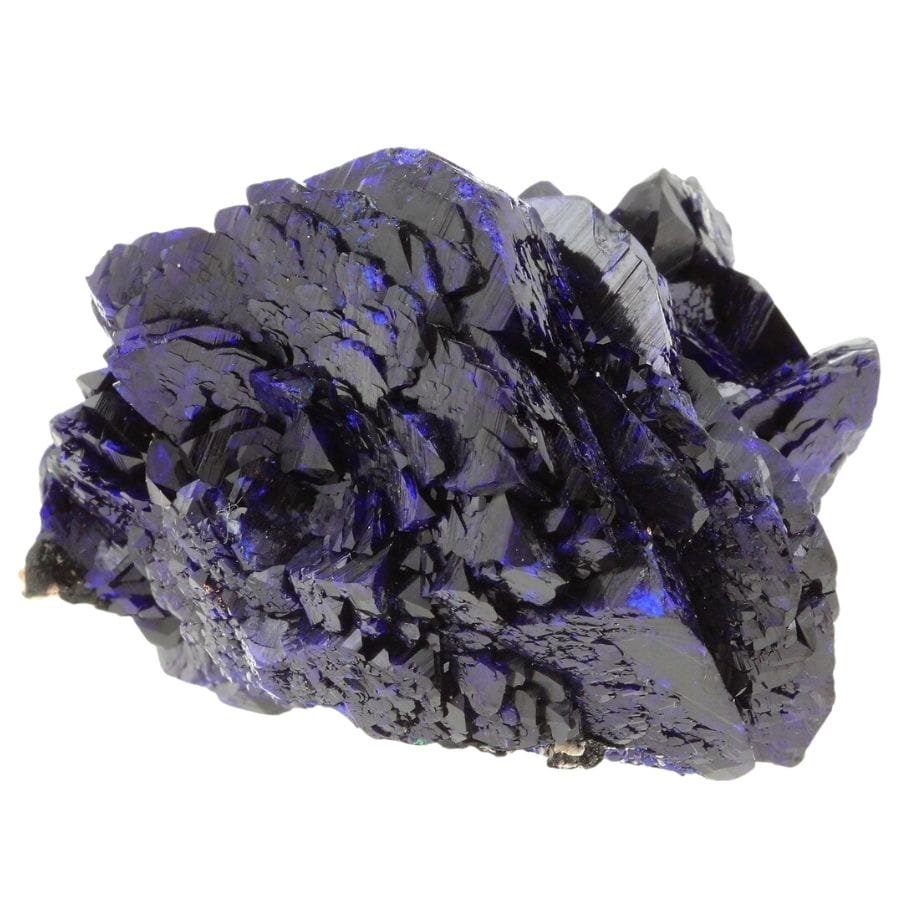
Azurite is a striking blue mineral that adds a splash of color to the collection of rocks and minerals found in Wisconsin. This vibrant mineral gets its rich blue hue from copper, which is a big part of what it’s made up of.
Over time, as copper ore is exposed to air and water, a chemical reaction takes place that creates azurite along with other minerals like malachite, which is also known for its own brilliant green color.
The process that forms azurite can take many years. It involves copper-rich water seeping into tiny cracks in rocks. As the water evaporates, it leaves behind copper, which then combines with carbon dioxide and other elements.
People value azurite for several reasons. Its color is the most obvious one – there aren’t many minerals that can match the beauty of azurite’s royal blue.
Then there’s its use in jewelry and decorative pieces. Its rich color can really make a simple necklace or a piece of decor pop. But it’s not just about looks; azurite also has practical uses.
Because it contains copper, it can be processed to extract this metal, which is used in everything from electric wires to coins.
Where you can find azurite in Wisconsin
- Upper Mississippi Valley Mining District, Iowa County
- Ladysmith, Rusk County
- Wauzeka, Crawford County
Calcite
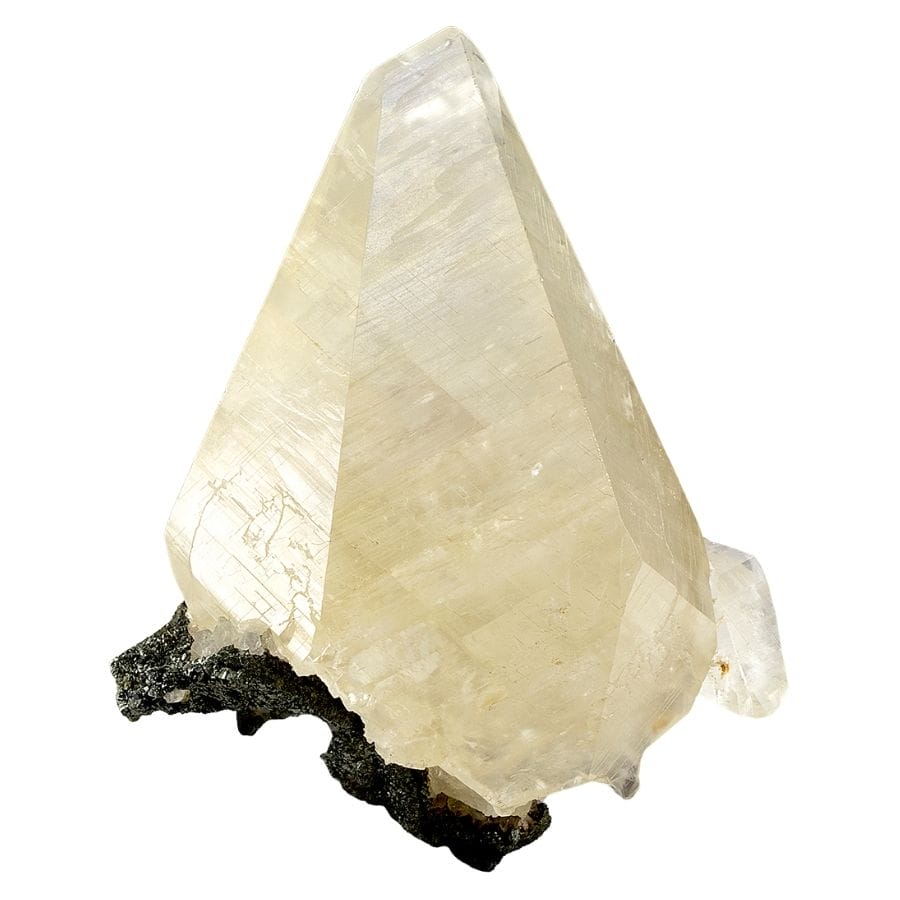
Calcite is a common but fascinating mineral that’s part of the rocks found in Wisconsin. It’s known for its bright white color, but it can also be found in a range of other shades, including pink, yellow, and blue.
This mineral forms in a variety of ways, often as a result of the buildup of shells and skeletons of sea creatures over millions of years. As these layers get compacted, they harden and turn into limestone, which is made mostly of calcite.
In other cases, calcite forms from hot, mineral-rich waters that fill cracks in the Earth’s surface. As the water cools down, calcite crystals start to grow. These crystals can be quite large and incredibly clear, sometimes looking almost like ice.
One of the coolest things about this mineral is how it reacts to acid. If you drop vinegar on calcite, it will fizz. It also has a property called birefringence, which means it can split light into two paths.
Because calcite is so abundant, it has a bunch of uses in everyday life. It’s used to make cement, toothpaste, and even some types of makeup. For collectors, calcite’s different colors and crystal shapes make it a fun addition to their collections.
Where you can find calcite in Wisconsin
- Mississippi River
- Lake Winnebago
- Mineral Point, Iowa County
Fluorite
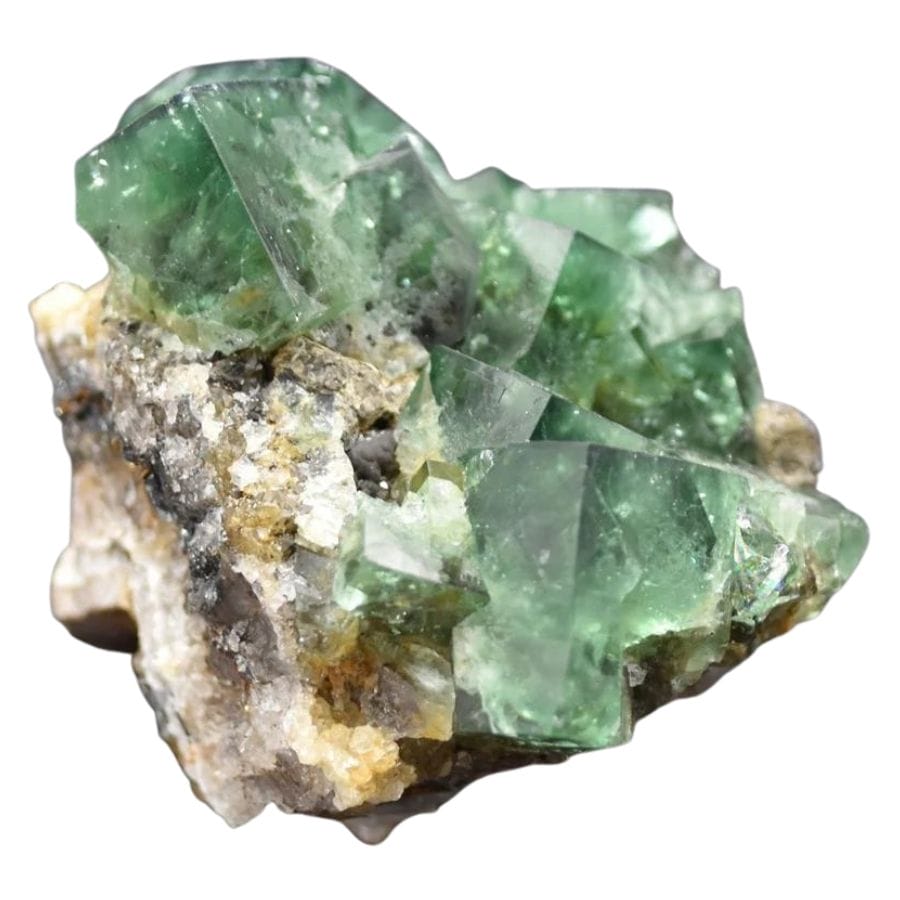
Fluorite is a colorful mineral that brightens up the collection of rocks found in Wisconsin. It comes in a rainbow of colors: from purples to greens, to yellows, and even colorless. It’s easy to see why so many people are drawn to it.
This mineral forms when hot, watery fluids move through rocks deep underground. These fluids are full of different ingredients that, under the right conditions, come together to create fluorite.
The process that forms fluorite can happen in the cracks of rocks or around hot springs. When the temperature and pressure are just right, the chemicals in the water begin to crystalize. This can happen quickly or over millions of years.
Fluorite crystals are usually shaped like cubes or octahedrons, and they can be really small or grow large enough to fill a room.
Its bright colors and crystal shapes make it popular in jewelry and decorative pieces. Plus, under ultraviolet light, some fluorite even glows with an amazing fluorescent light.
Where you can find fluorite in Wisconsin
- Sturgeon Bay, Door County
- Morris pit, Green Lake, Green Lake County
- Vesper, Wood County
Galena
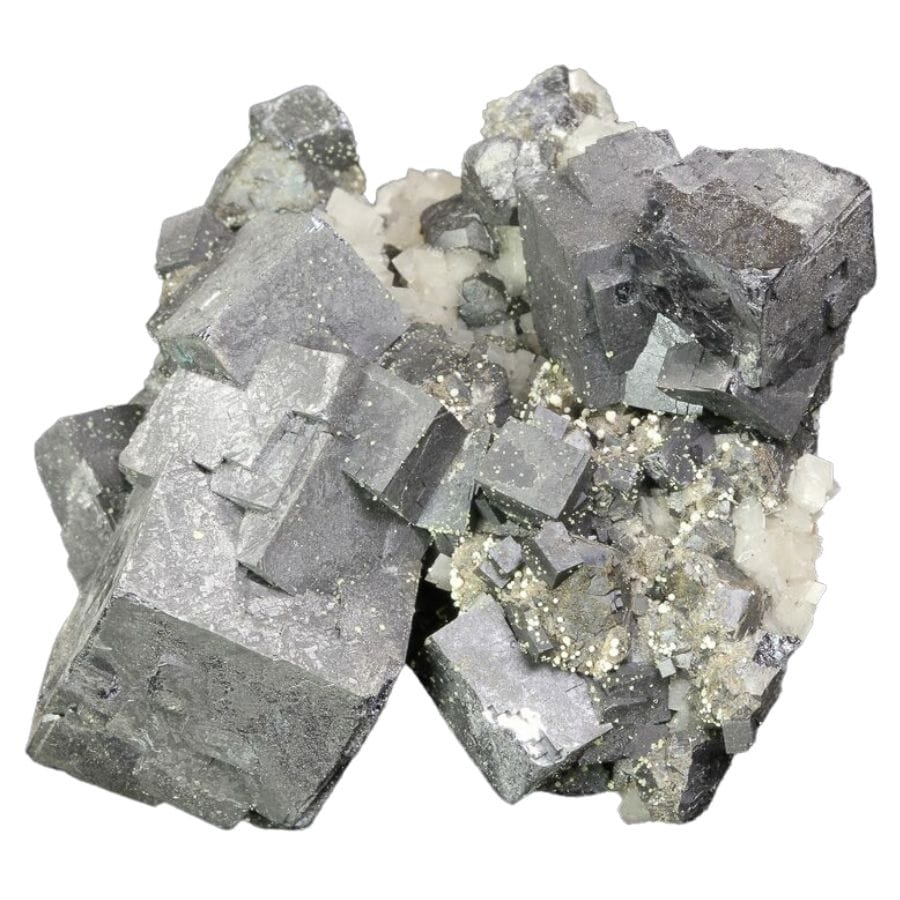
Galena is a shiny, gray mineral that’s not only cool to look at but also one of the most valuable rocks in Wisconsin. It’s the main source of lead and has been mined for over a thousand years.
This mineral often forms in areas where there are hot springs or in regions with limestone that’s been changed by heat and pressure over a long time.
In these environments, fluids rich in minerals seep through the cracks and spaces in the ground, and as they cool down, they leave behind chunky cubes or octahedral crystals of galena.
The look of galena is pretty distinctive. It has a bright metallic luster and is heavy for its size because of its lead content.
In the past, galena was important because it was used to make lead for bullets. Now, it’s mostly used in lead-acid batteries and in the shielding around X-ray machines.
Galena is a favorite of rock collectors because it’s easy to identify and often found in well-formed crystals that are perfect for display.
For those interested in the history of mining, galena is a symbol of the rich mining past of regions like Wisconsin, where it played a big role in the local economy.
Where you can find galena in Wisconsin
- Upper Mississippi Valley Mining District, Lafayette County
- Rio, Columbia County
- Pine Bluff, Dane County
Lake Superior Agate
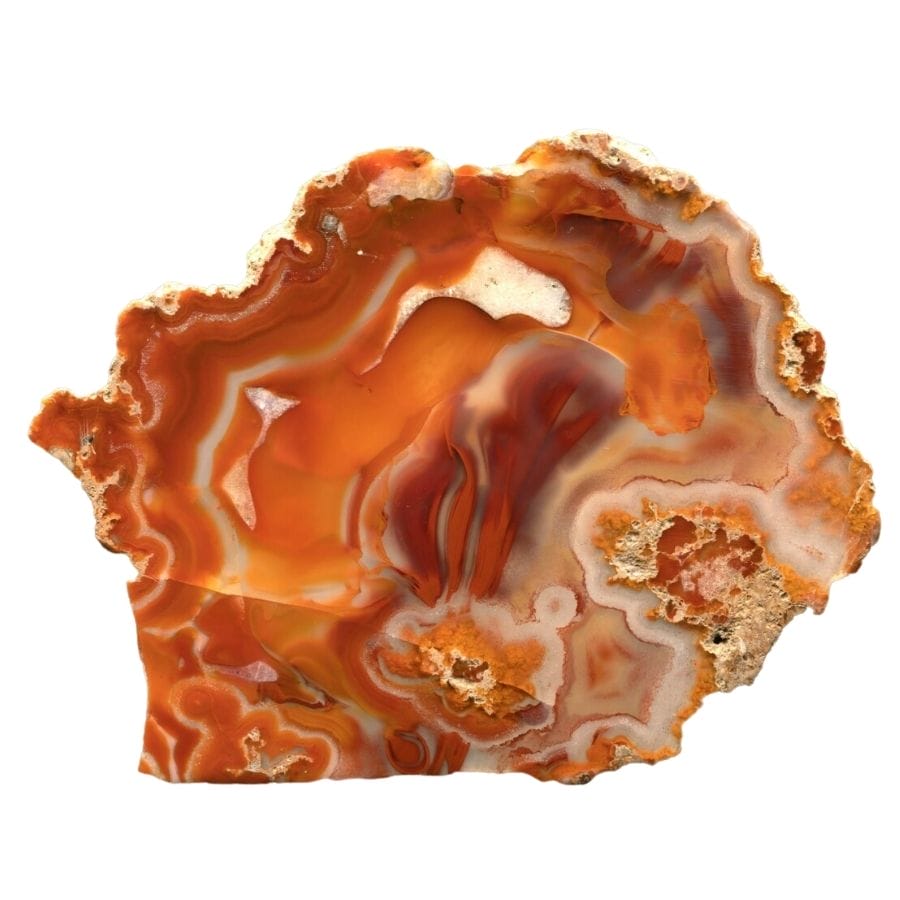
Lake Superior agate is a type of agate cherished by many for its stunning colors and patterns. This special rock is named after Lake Superior, where it’s commonly found.
It formed over a billion years ago when the North American continent began to split apart, creating rifts that were later filled by molten rock.
As the molten rock solidified, gas bubbles were trapped, and over time, these hollow spaces were filled with layers of quartz and other minerals, giving birth to the Lake Superior agate.
The process took an incredibly long time, with layers upon layers forming the intricate bands that make each agate unique.
These bands come in a kaleidoscope of colors, from reds and oranges to yellows and whites, often interlaced in a way that catches the eye.
Their beauty is why people love to find and collect them. The colors actually come from iron, which is plentiful in the area, and they can tell a lot about the different conditions under which each stone was formed.
Lake Superior agates are prized for their natural beauty and because they can polish up really well, making them great for jewelry and decorative items. Their hardness and durability mean they’re not just pretty; they’re also long-lasting.
Where you can find Lake Superior agate in Wisconsin
- Prairie du Chien, Crawford County
- Chequamegon Bay
- Big Bay State Park
Magnetite

Magnetite is an iron oxide mineral that’s often pulled from the ground in Wisconsin. It’s easy to spot because it’s usually black or brownish-black, with a strong, metallic shine and it feels heavier than other rocks of the same size.
What makes magnetite really cool is that it’s naturally magnetic, one of the few minerals that can attract a magnet or even act as a magnet itself.
This rock forms in different ways, but a lot of it comes from volcanic activity that happened a long time ago. When hot lava comes out of a volcano and cools down, magnetite can grow in the lava.
It can also form from iron being dissolved in water that’s deep underground. The iron joins with oxygen, and then it crystallizes into magnetite.
Magnetite is super useful. Since it’s made mostly of iron, it’s used a lot to make steel. That means it’s part of building skyscrapers, bridges, and cars — it’s a big deal in our daily lives.
It’s also used in electronics and even in magnetic resonance imaging (MRI) machines in hospitals.
Where you can find magnetite in Wisconsin
- Black River Falls
- Gogebic Range, Iron County
- Jackson County Iron Mine, Jackson County
Sphalerite
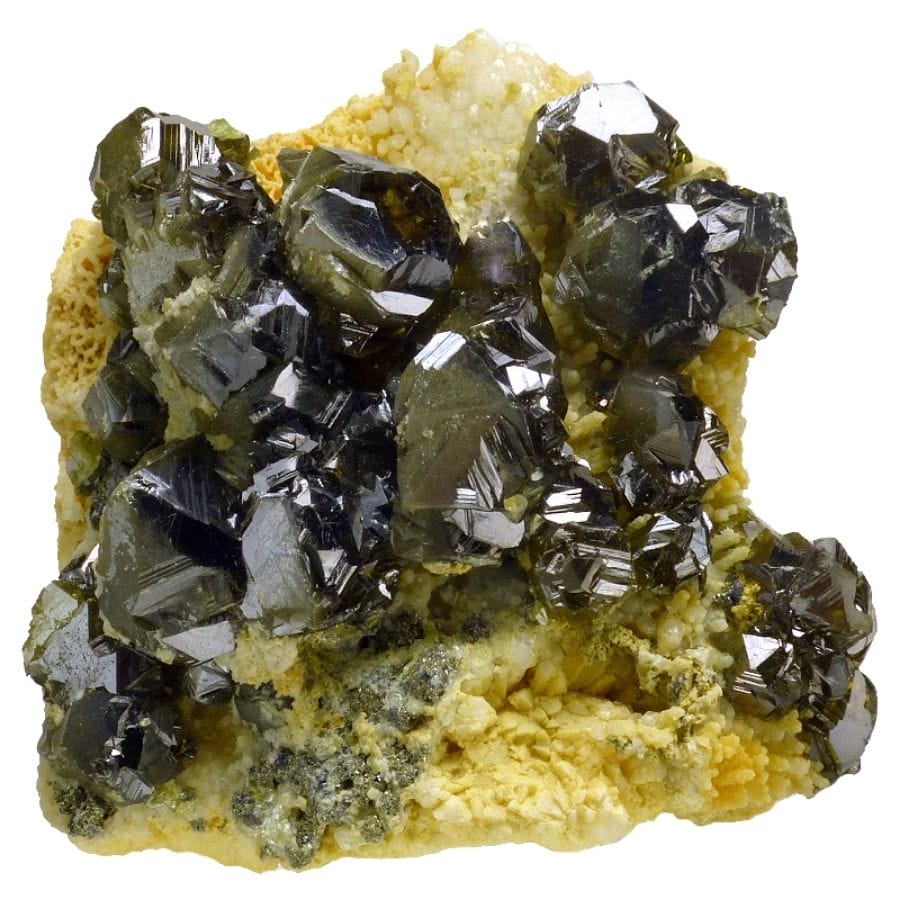
Sphalerite is a mineral that’s not only fun to say but also a blast to learn about, especially when you find it among the rocks of Wisconsin.
This mineral can be quite the chameleon, appearing in different colors, from brown to red to black, and it often has a shiny, gem-like quality.
Sphalerite is made up of zinc and sulfur, and sometimes it has traces of other elements like iron or cadmium, which can change its color.
The way sphalerite forms is pretty interesting. It usually happens in areas where there are hot fluids deep under the Earth’s surface. These fluids dissolve minerals and carry them through the rocks.
When the fluid cools down or reacts with other chemicals, sphalerite can start to grow. It often shows up with other minerals like galena, which is a lead ore, or with minerals that contain copper.
Sphalerite is the main source of zinc, which is super important for making things like galvanized steel to protect against rust, brass for musical instruments, and even the zinc oxide used in sunscreen.
Plus, because sphalerite can be so shiny and pretty, it’s sometimes cut into gemstones for jewelry.
Where you can find sphalerite in Wisconsin
- Hazel Green, Lafayette County
- Morris Pit, Green Lake, Green Lake County
- Racine, Racine County
Adularia
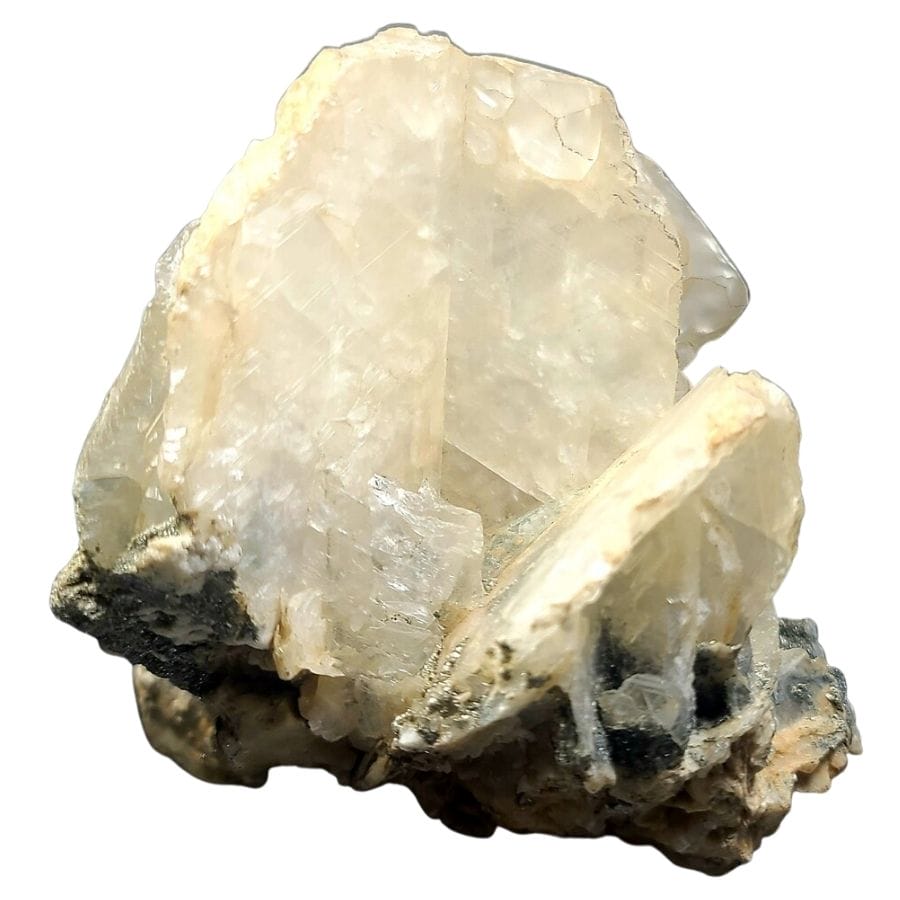
Adularia is a type of feldspar that has a special charm, and it’s one of the many gemstones found in Wisconsin. This mineral has a pearly sheen and can range in color from colorless to a soft shade of white or even light blue.
It’s often found in areas where the rocks have been altered by heat and pressure, a process geologists call metamorphism.
The heat and pressure change the structure of the rocks, and as the conditions start to cool down and stabilize, adularia begins to form in the cracks and spaces where the rocks have been broken apart.
What’s really cool about adularia is the effect called adularescence, which makes the stone seem to glow from within with a moon-like light. This happens because of the way the mineral’s internal structure scatters the light that enters it.
People value adularia for this unique glow. It’s often used in jewelry to create pieces that have a gentle and eye-catching sparkle.
Adularia can also be a collector’s delight because of its association with the moon and its gentle appearance, which makes it quite different from more flashy gemstones.
Where you can find adularia in Wisconsin
- Johnson Materials Co. Quarry, Douglas County
- Dresser Trap Rock Quarry, Polk County
Aventurine
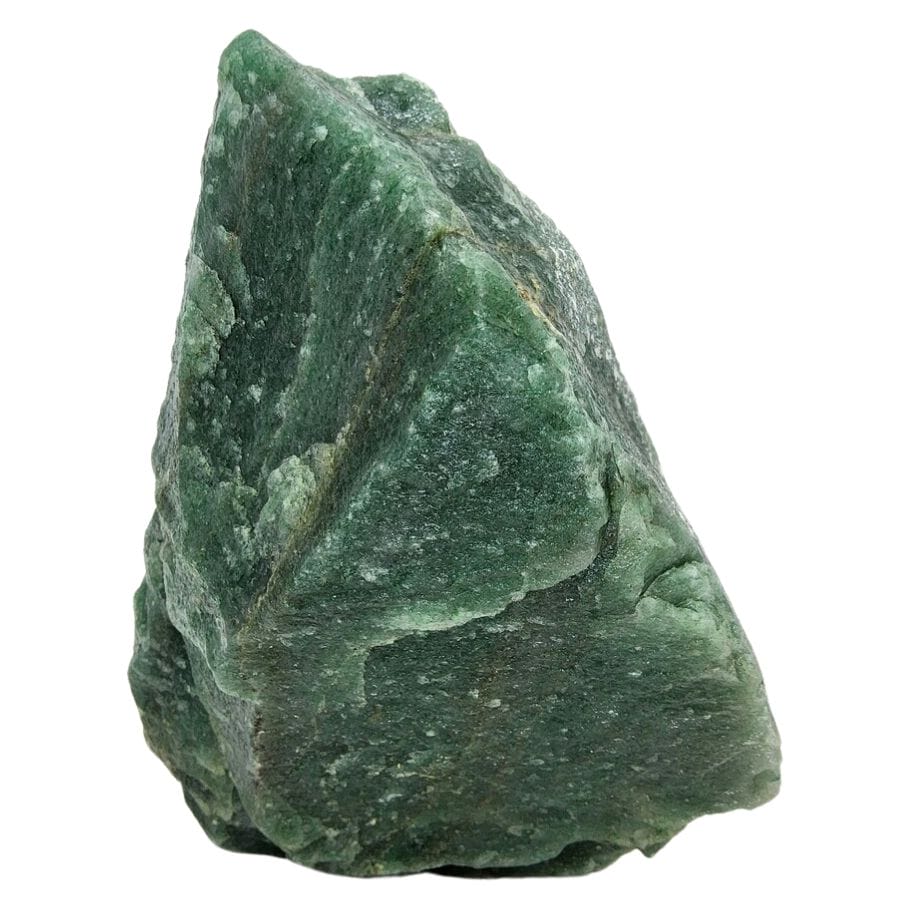
Aventurine is a kind of quartz that really catches the eye, thanks to its sparkly appearance. It’s usually green, but it can also come in orange, brown, yellow, blue, or gray.
The sparkle of aventurine comes from tiny pieces of other minerals, like feldspar or mica, that get mixed in while the quartz is forming. These little bits reflect light, giving aventurine a glittery look that’s really special.
The way aventurine is formed is part of what makes it so interesting. It starts out when molten rock, called magma, cools down and starts to harden. If the conditions are just right, quartz begins to crystallize from this cooling magma.
As it crystallizes, other minerals can become trapped inside, and these are what give aventurine its shimmer.
Aventurine can be used in jewelry and decorative objects. The stone is fairly hard, so it can be cut into various shapes and polished to a bright shine, making it perfect for necklaces, bracelets, and rings.
Where you can find aventurine in Wisconsin
- Veedum Quarries, Wood County
Celestine
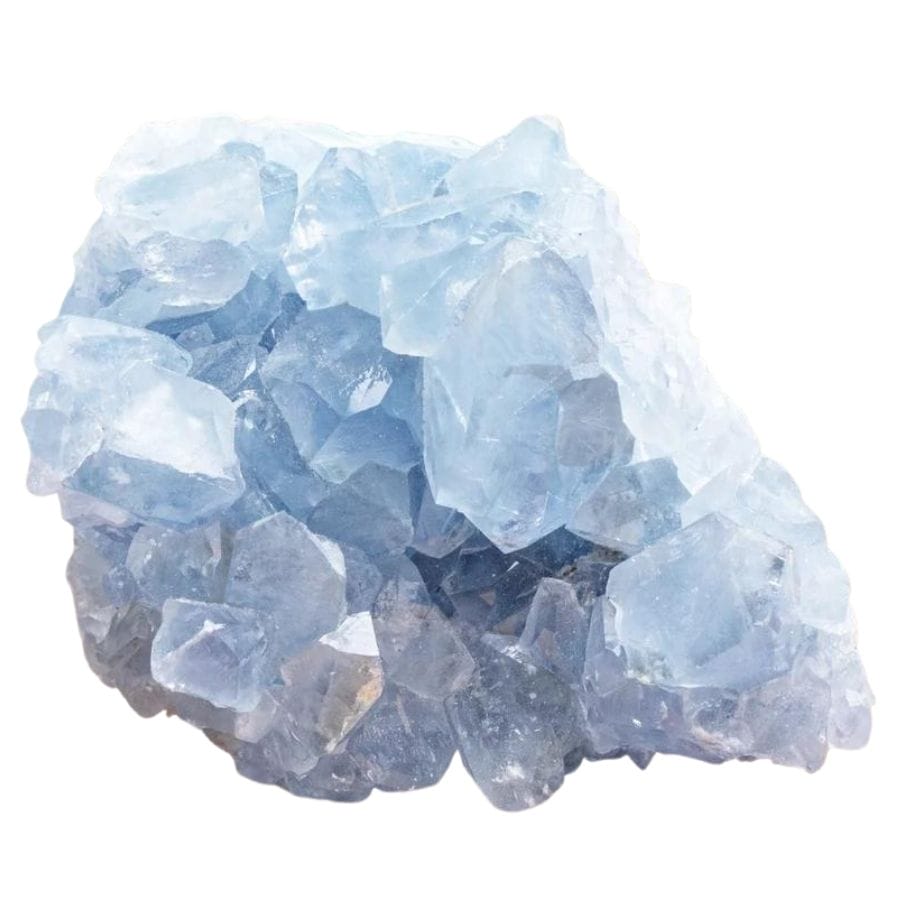
Celestine, also known as celestite, is a mineral that’s as cool as its name, showing up in the rocks of Wisconsin with its soft blue glow. This mineral is made up of strontium sulfate, and it forms crystals that can be quite large and striking.
It forms in a variety of ways, often when mineral-rich waters seep into rock formations and start to evaporate.
As the water goes away, celestine has the chance to crystallize. This can happen in sedimentary rocks like limestone or gypsum.
Sometimes, it’s found in the cracks of rocks, where it grows in beautiful clusters that are a sight to behold.
Celestine is used to make certain kinds of metal strontium, which goes into making fireworks and in the medical field for imaging.
But beyond its practical uses, celestine is a favorite among mineral collectors because of its beauty. Its pale blue crystals can be cut and polished for jewelry, or just displayed as they are, adding a touch of sky-blue calm to any room.
Where you can find celestine in Wisconsin
- Gogebic Range, Iron County
- Kenosha, Kenosha County
- Mackville quarry, Outagamie County
Lepidolite
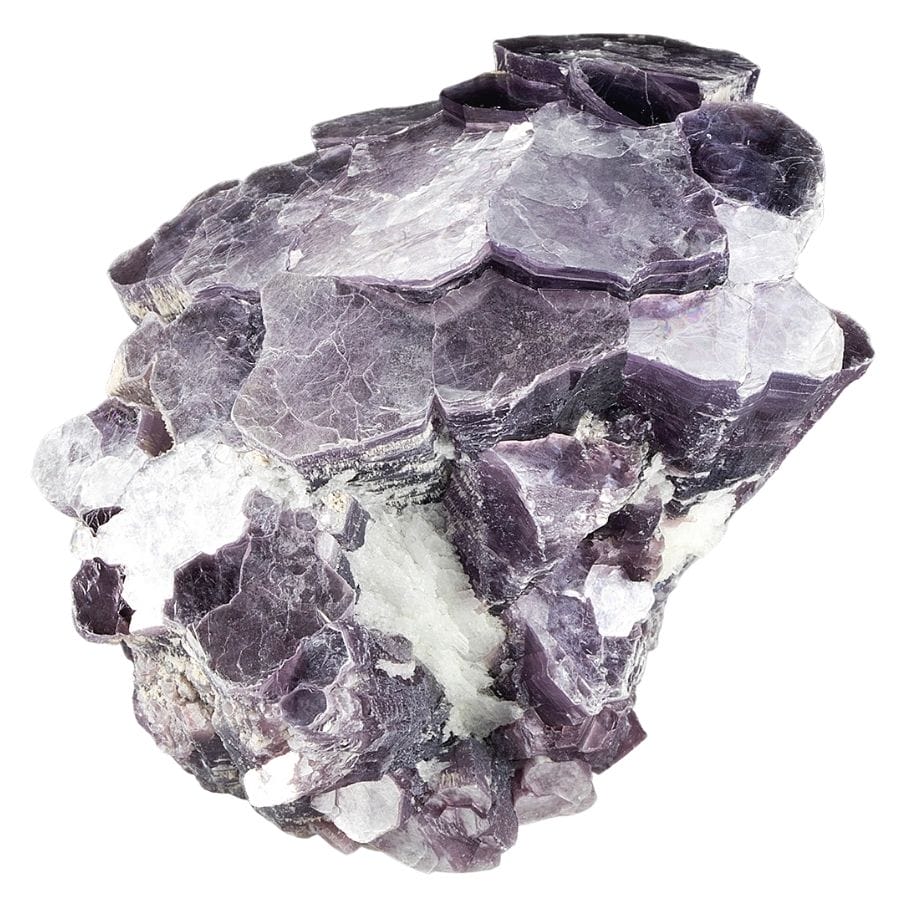
Lepidolite is a mineral that stands out because of its rich lilac or rose-violet color. It’s a kind of mica, which is a group of minerals known for their ability to split into flat sheets.
Lepidolite is found in pegmatites, which are rocks formed from magma—the hot liquid rock deep beneath the Earth’s surface.
When this magma cools slowly, it can create large crystals, and if the conditions are just right, lepidolite forms among these crystals.
This mineral is actually a major source of lithium, which is a metal used in batteries, including the ones for electric cars and smartphones.
Besides lithium, lepidolite often contains tiny amounts of other elements that can give it a range of colors from pink to purple. It’s the presence of these elements that can make lepidolite sparkle in the light.
However, lepidolite is more than just its lithium content. Its beautiful colors and sparkle make it popular in jewelry and as a specimen for collectors.
Where you can find lepidolite in Wisconsin
- Fern, Florence County
Prehnite
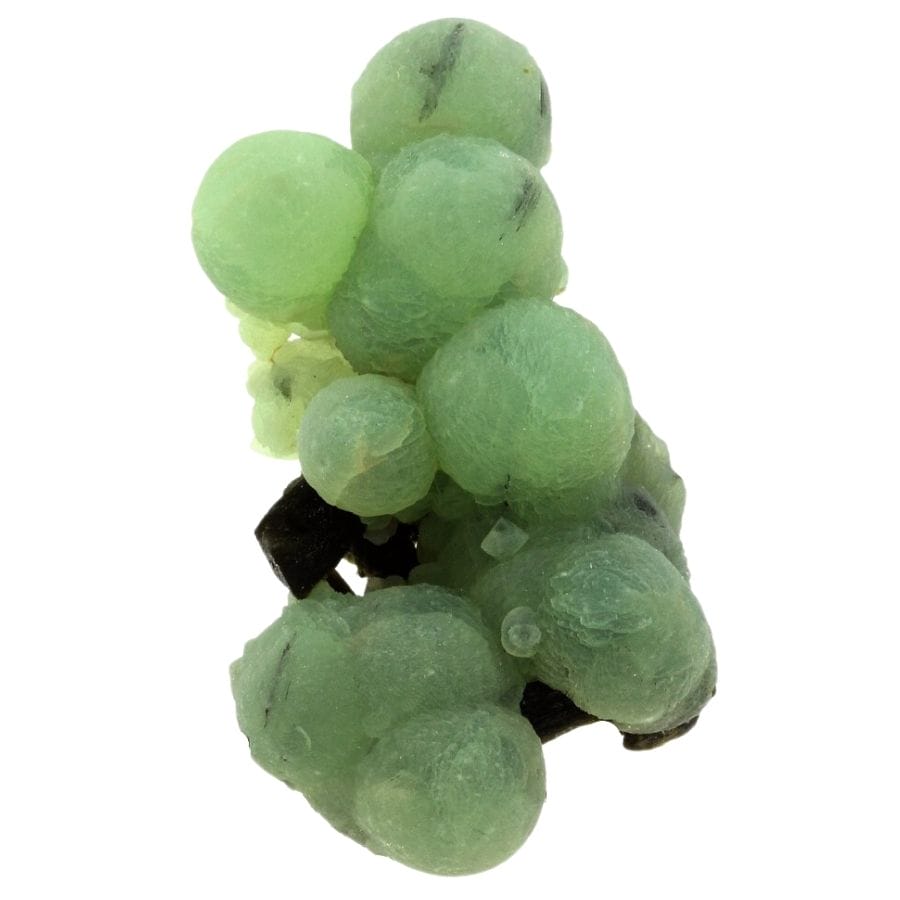
Prehnite is a gemstone that adds a touch of green to the palette of types of rocks found in Wisconsin. This stone, usually a soft green to yellow-green in color, has a glassy sheen and can sometimes be translucent.
Prehnite forms in the voids and fractures of igneous rocks, the kind that come from cooled lava. It’s one of those cool minerals that can form crystal clusters that look like bunches of grapes.
The way prehnite is made starts deep underground where conditions are just right for minerals to get dissolved in water. This mineral-rich water moves through rocks and, as it goes, it leaves behind prehnite.
The crystals grow in spaces where other minerals once were but have since dissolved away, which is why they often have a shape that looks like they’re hugging the rock around them.
People value prehnite for a couple of reasons. It’s not only a pretty stone to look at, but it also has a striking appearance, making it popular in jewelry and ornaments.
Where you can find prehnite in Wisconsin
- Brule River, Douglas County
- Upper Eau Claire Lake, Bayfield County
- Saxon Falls, Iron County
Rhodochrosite
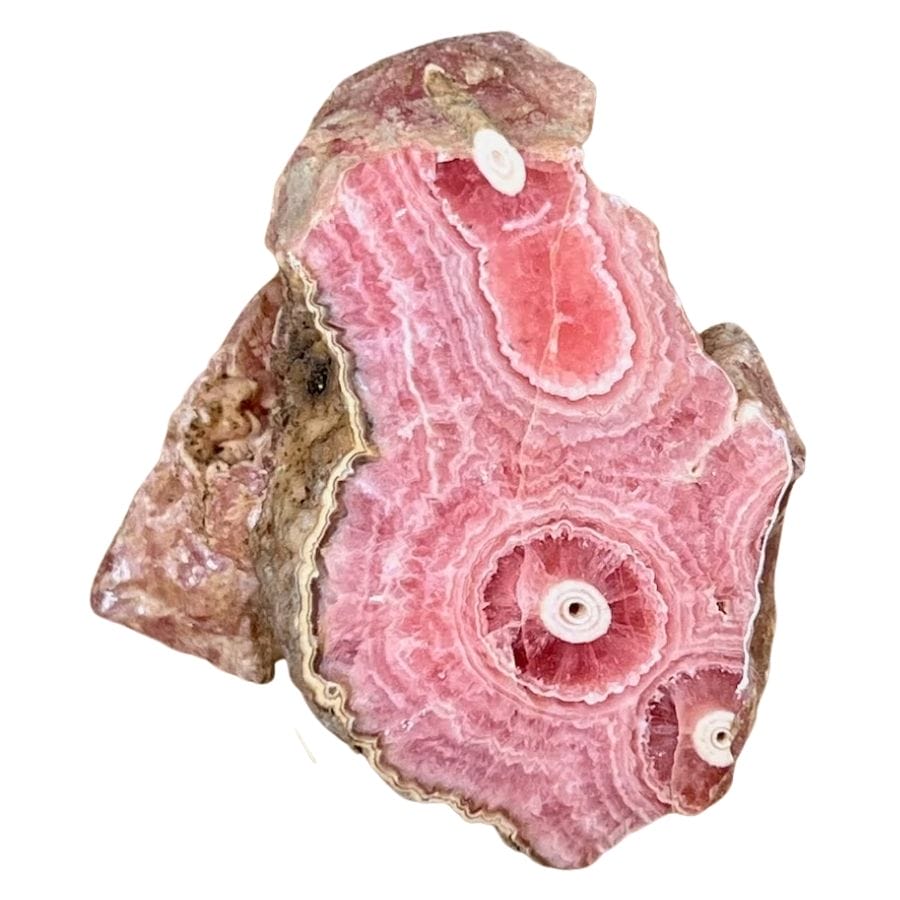
Rhodochrosite is a mineral that stands out with its warm, rosy pink hues, making it a vibrant member of the rocks found in Wisconsin.
This mineral is typically formed in the gaps of sedimentary rocks, where mineral-laden waters flow through and deposit layers upon layers of manganese carbonate, the main component of rhodochrosite.
Over time, these layers build up and crystallize into the stones that catch the eye with their rich color and patterns.
When water travels through manganese-rich areas, it picks up elements along the way. As it moves through cracks and crevices in the rock, it deposits these elements, and with the right conditions, rhodochrosite begins to grow.
It’s often found alongside other minerals like quartz, calcite, and fluorite, creating a dazzling array of color beneath the Earth’s surface.
While rhodochrosite is a favorite among mineral collectors for its unique color and crystal shapes, it’s also used in the production of manganese, an essential metal in the steel industry.
Where you can find rhodochrosite in Wisconsin
- Gogebic Range, Iron County
Variscite
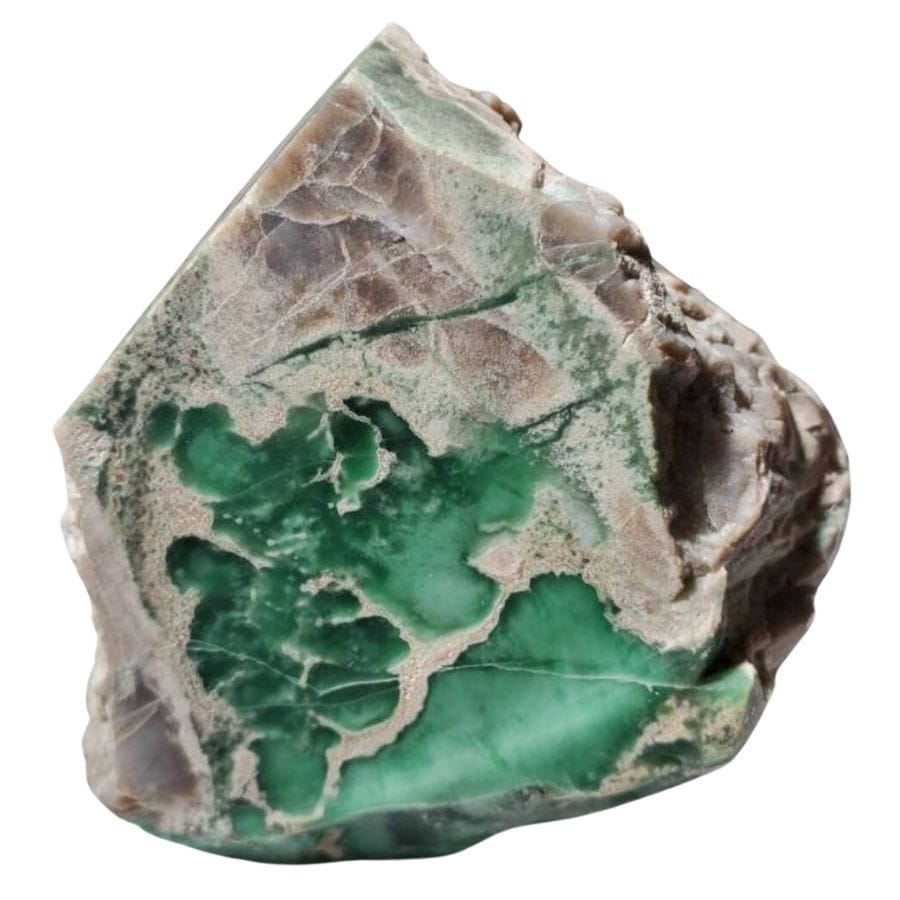
Variscite is a gemstone that adds a touch of unique beauty to the array of gemstones found in Wisconsin.
This mineral typically showcases a range of colors from light green to bluish-green and sometimes has white or dark veins running through it.
It forms when phosphate-rich water seeps into the ground and reacts with aluminum-rich rocks under specific conditions.
Over time, this interaction creates the mineral known as variscite, which is often mistaken for turquoise because of its similar color.
This gemstone usually grows in nodules or crusts and is often found in association with other phosphate minerals.
Its formation can occur in various environments, especially in near-surface, low-temperature conditions, such as the weathering of rocks.
The result is variscite’s distinctive color and pattern, which make it a standout specimen for any collection.
Variscite has a nice color and is often used in jewelry as cabochons, beads, or carvings. The unique patterns within each piece mean that no two variscite gemstones are exactly alike, giving a special individuality to any item they’re used in.
Where you can find variscite in Wisconsin
- Eau Claire Formation sandstones, Jackson County
The Crystals Found In Wisconsin
Wisconsin, with its unique geological features, is home to a variety of beautiful and intriguing crystals. Check out our guides to finding crystals in the state.
Chrysocolla
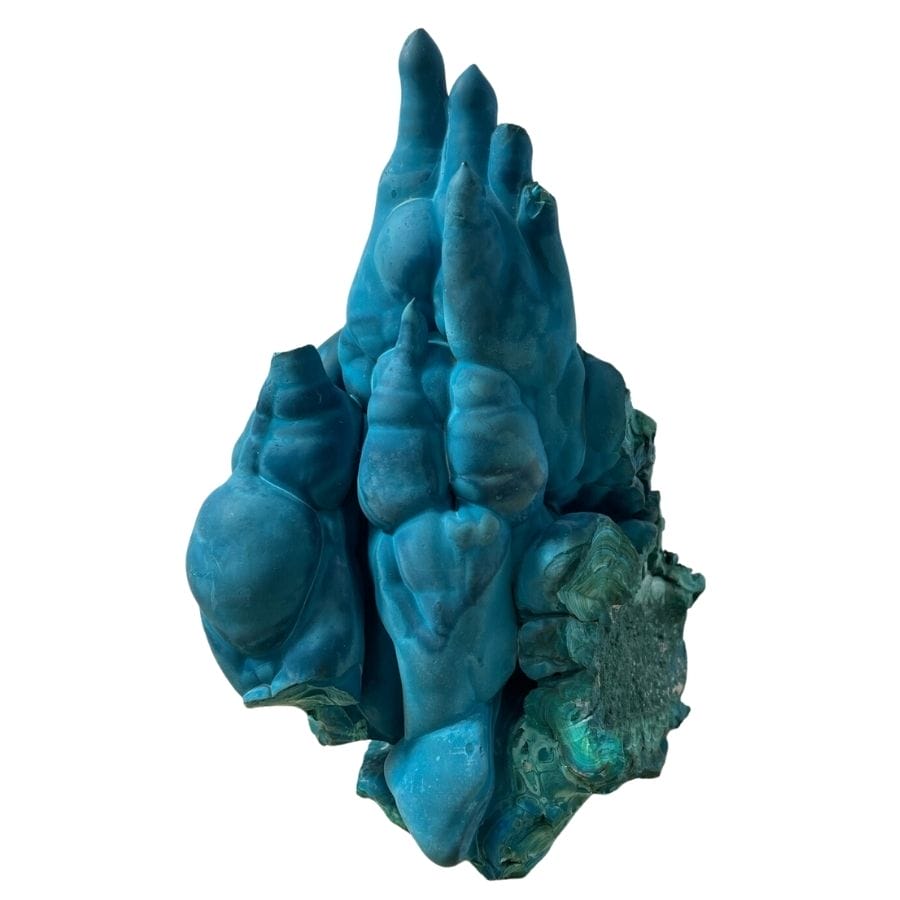
Chrysocolla is a captivating mineral with a vibrant blue-green color that stands out among the rocks and minerals found in Wisconsin.
This mineral forms where copper deposits are exposed to oxygen and water, a process that often occurs in the arid regions where copper mining takes place.
Over time, copper reacts with the air and water, and chrysocolla begins to take shape, typically in the spaces and cracks within the host rock.
The striking appearance of chrysocolla is due to its copper content, which gives it that signature turquoise color.
It’s often found mixed with other copper-based minerals like malachite, azurite, and turquoise, creating a dazzling array of colors that can be quite breathtaking.
Chrysocolla is also interesting to collectors who value the story behind how minerals are formed.
Where you can find chrysocolla in Wisconsin
- Ladysmith, Rusk County
- Upper Mississippi Valley Mining District, Iowa County
Covellite
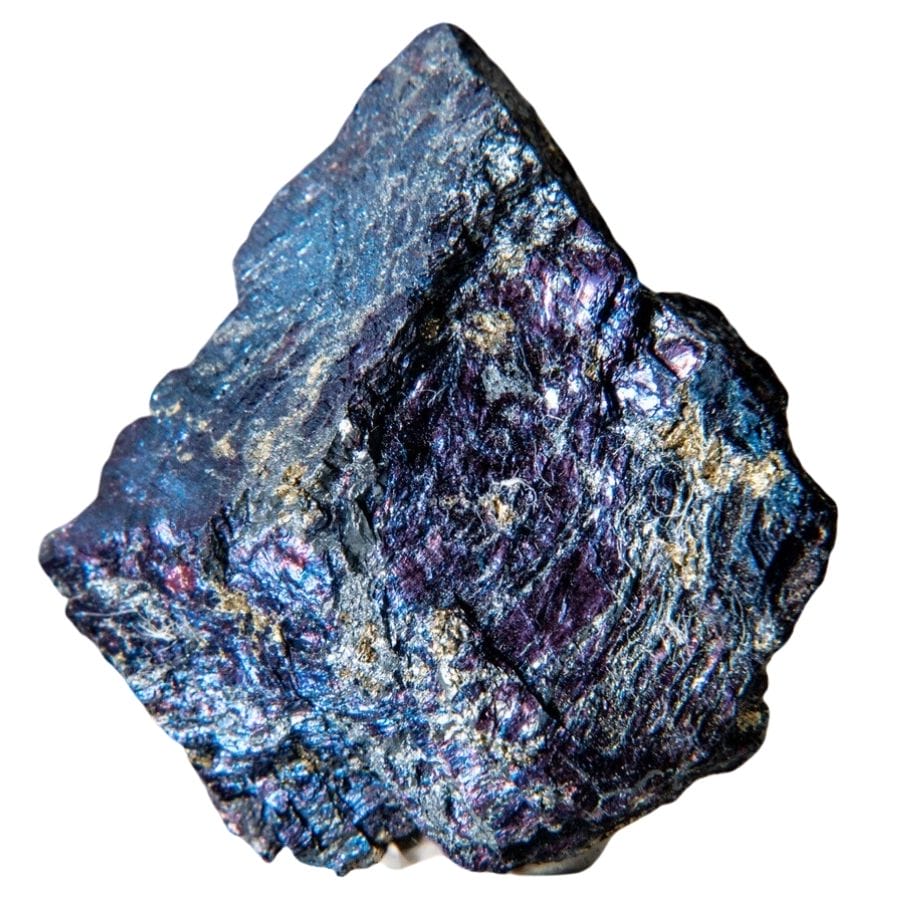
Covellite is a rare and striking mineral known for its deep indigo and blue colors. It’s one of the unique crystals found in Wisconsin, catching the eye of anyone interested in the quieter yet colorful side of geology.
This mineral is actually a copper sulfide and forms through the alteration of other copper sulfides, such as chalcopyrite and bornite.
It typically happens in the presence of sulfur-rich solutions where copper minerals are being weathered or broken down.
The way covellite takes shape can be quite a sight. It often forms thin, iridescent layers that show a range of blues, purples, and sometimes reds or golds, depending on the angle and the light.
It’s not just the color that’s fascinating; covellite can also have a metallic luster, which makes it shimmer in the light. Sometimes, it forms hexagonal crystals that can be quite striking in appearance.
In addition to being a source of copper, covellite is also admired by mineral collectors for its unique beauty. Covellite can be used in jewelry, though it’s less common because of its softness.
Where you can find covellite in Wisconsin
- Ladysmith, Rusk County
- Oshkosh, Winnebago County
- Upper Mississippi Valley Mining District, Iowa County
Epidote
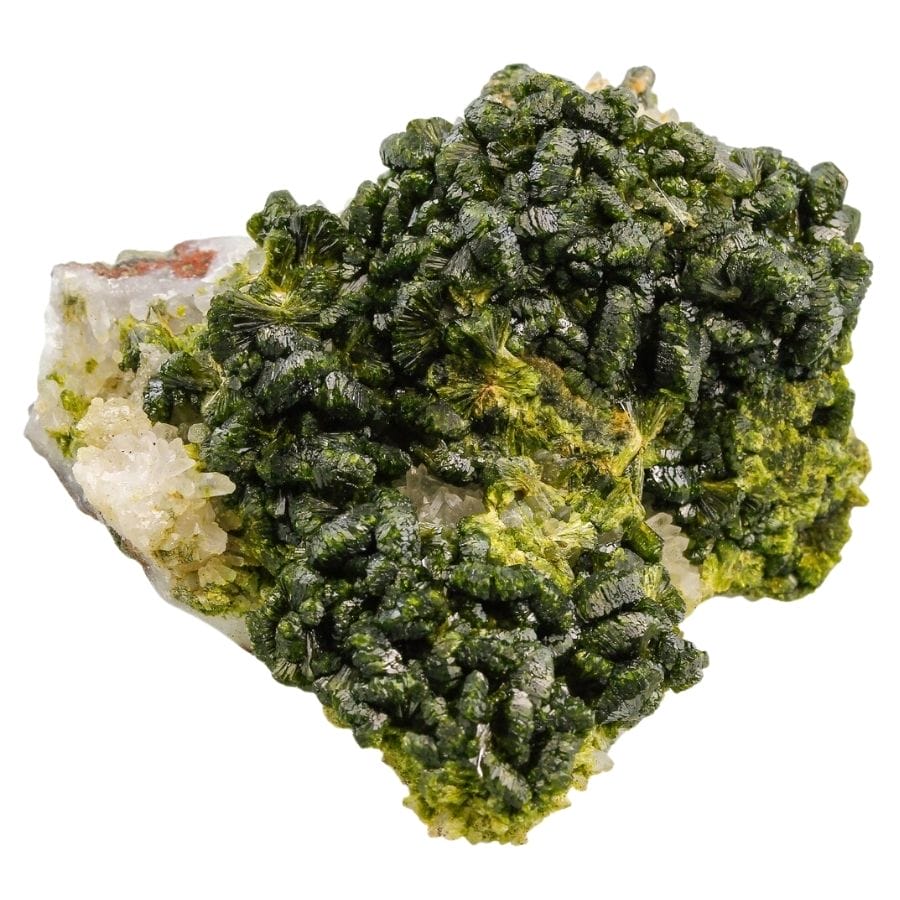
Epidote comes to life under conditions of high pressure and temperature, often as a result of regional metamorphism where rocks are fundamentally altered by these intense conditions.
It forms when calcium, aluminum, iron, and oxygen get together and conditions are just right, often in the company of minerals like quartz or calcite.
The unique characteristic of epidote is its pistachio-green color, which can be so deep and rich that it almost looks black. It’s known for its long, slender crystals that can be striated, meaning they have parallel lines down the sides.
These features make epidote a favorite among rock hounds and collectors who can recognize it by its distinctive look and the way it often associates with other minerals in a rock.
Epidote isn’t typically used in jewelry because it’s not as hard as some other minerals, but its color and crystal forms are highly appreciated by those who love minerals for their natural beauty.
Where you can find epidote in Wisconsin
- Dresser Trap Rock Quarry, Polk County
- Weyerhauser Copper Mines, Douglas County
- Jackson County Iron Mine, Jackson County
Malachite
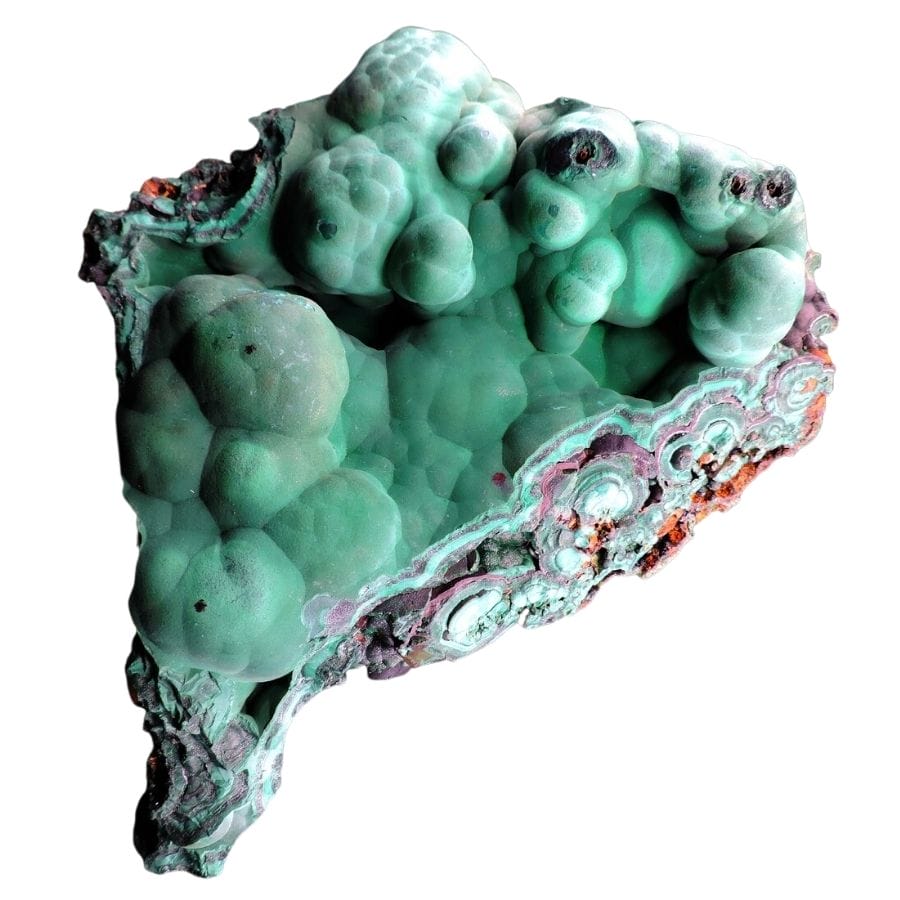
Malachite is a vibrant green mineral that stands out for its unique banded patterns and rich, velvety color, making it a highlight in Wisconsin rock identification.
This eye-catching mineral is formed from copper deposits, which, when exposed to oxygen and carbon dioxide, undergo a chemical transformation.
Water plays a crucial role too, as it carries dissolved copper into cracks and spaces where it reacts with other elements to slowly form malachite over time.
What’s really cool about malachite is its concentric rings or bands that come in various shades of green. These bands are the result of different conditions during the mineral’s formation, with each layer telling a part of the story of its creation.
Malachite is soft enough to be carved easily, which has made it popular throughout history for decorative objects.
For a lot of people, the value of malachite can be found in its distinctive look, which makes it a favorite among those who enjoy creating jewelry or ornamental pieces.
Beyond its beauty, malachite is also a copper ore, making it important in the production of this useful metal.
Where you can find malachite in Wisconsin
- Morris Pit, Green Lake, Green Lake County
- Dresser Trap Rock Quarry, Polk County
- Jackson County Iron Mine, Jackson County
Rose Quartz
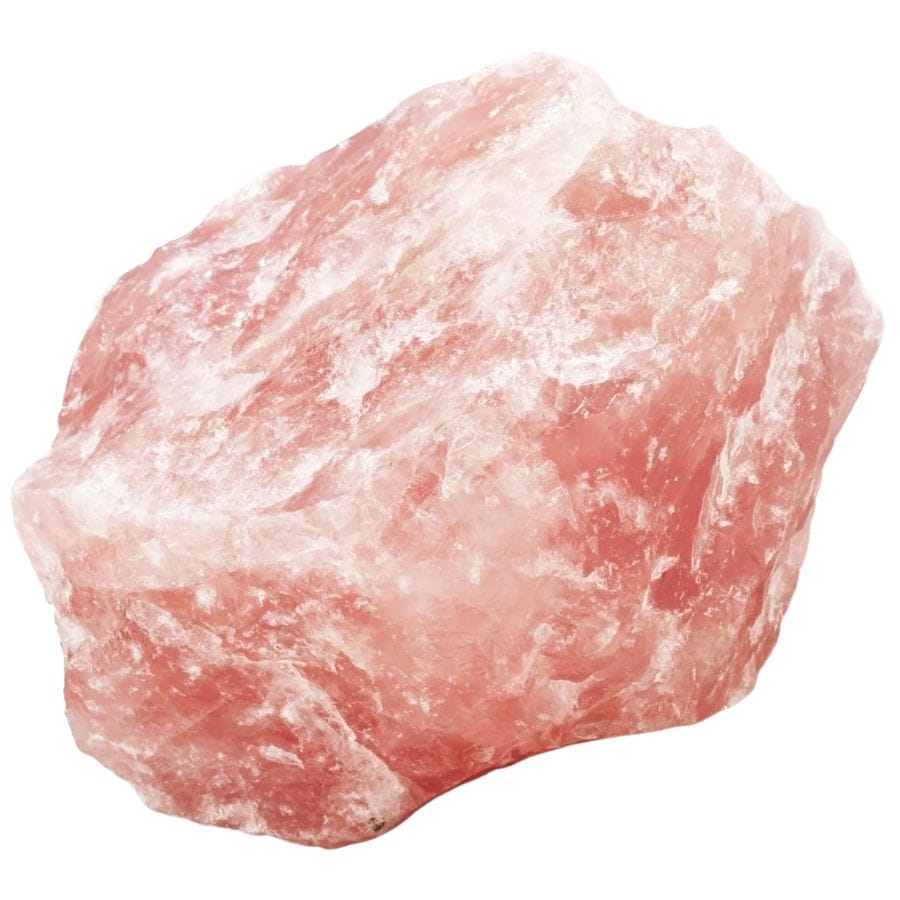
Rose quartz is a type of quartz that draws attention with its delicate pink color. It’s found among the rocks in Wisconsin, adding a blush of color to the state’s geological palette.
This pink gemstone is formed in igneous rocks, the kind that are made from cooled-down lava. The pink color comes from tiny traces of titanium, iron, or manganese.
This mineral usually forms in large masses, and unlike its crystal quartz cousins, it rarely forms into the well-defined crystals that people associate with quartz.
Instead, rose quartz is usually found in chunky masses with no visible flat surfaces or points. Despite this, it has a smooth and glassy look that’s quite striking, especially when polished.
People value rose quartz not just for its beauty but also for its uniqueness. It’s used in all sorts of jewelry, from necklaces to bracelets, giving a soft, romantic look.
Where you can find rose quartz in Wisconsin
- Wisconsin Rapids, Wood County
Wavellite
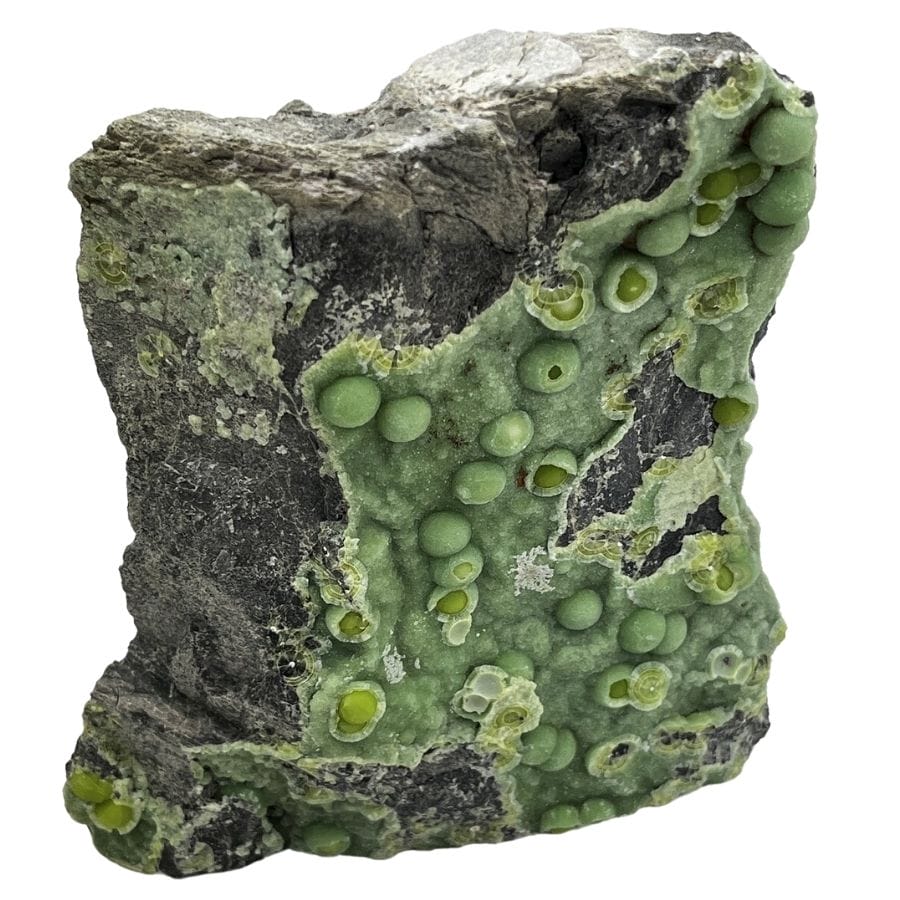
Wavellite is an interesting mineral that has radial clusters of needle-like crystals and its rich, green color.
This mineral forms in fractures and cavities of certain types of rocks, particularly those that are rich in phosphate, like aluminum-rich rocks that have been altered by weathering and the action of water.
The process of wavellite’s formation can occur in both high and low temperatures, making it a versatile mineral.
It’s often found lining the inside of cracks in the rocks, where it forms those characteristic starburst patterns that can be strikingly beautiful.
Wavellite’s radial clusters are a delight for mineral collectors who appreciate the intricate designs that nature can produce. These patterns are not just pretty; they tell geologists a lot about the environment where the wavellite grew.
Aside from being appreciated for its appearance, wavellite is also used as a minor ore of aluminum.
Where you can find wavellite in Wisconsin
- Eau Claire Formation sandstones, Jackson County
Zoisite
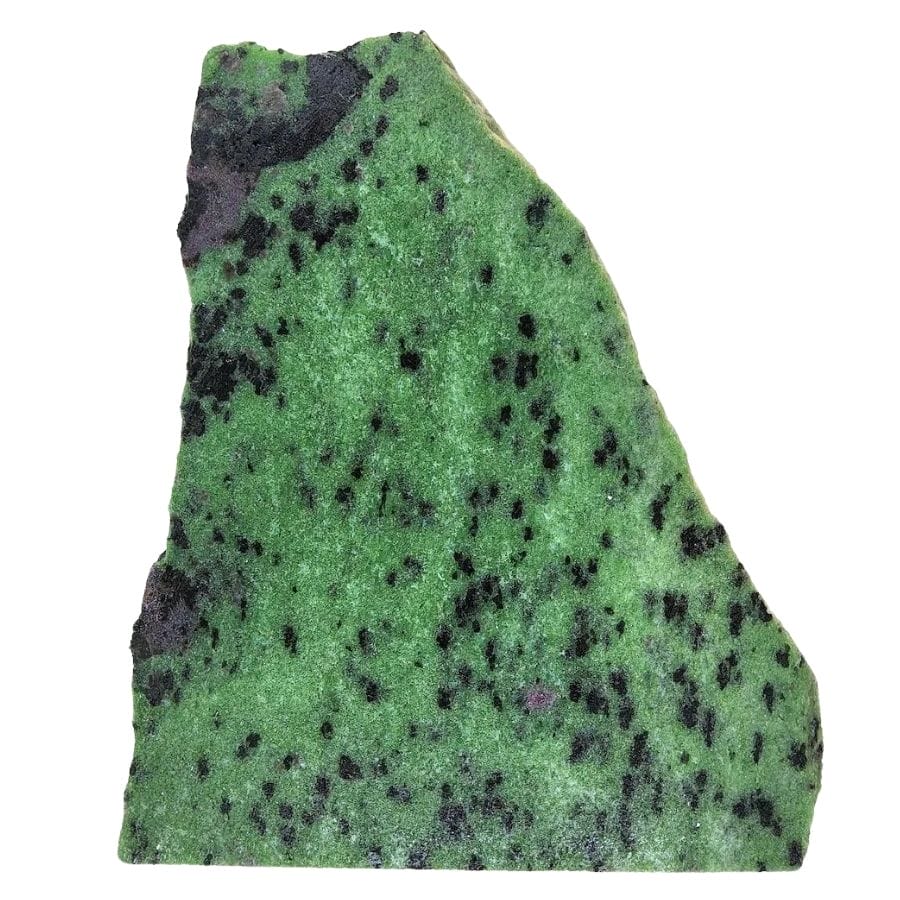
Zoisite is one of the many fascinating crystals found in Wisconsin, offering a glimpse into the state’s diverse geology. It’s a mineral that comes in a variety of colors, though it often appears as green.
Zoisite is typically formed in metamorphic rocks, which are rocks that have been changed by extreme heat and pressure inside the Earth.
The presence of different elements like chromium or vanadium can influence its color range, resulting in a vibrant display.
What makes zoisite particularly interesting is that it sometimes contains ruby crystals within it, creating a stunning contrast of colors. This combination is known as anyolite and is highly sought after for its beauty and rarity.
Zoisite can be cut and polished to create beautiful jewelry pieces, with the greener variety known as tanzanite being especially prized for its deep blue and violet shades.
Where you can find zoisite in Wisconsin
- Mellen, Ashland County
- Artus Creek Greenstone, Marathon County
- Dresser Trap Rock Quarry, Polk County
Diamond
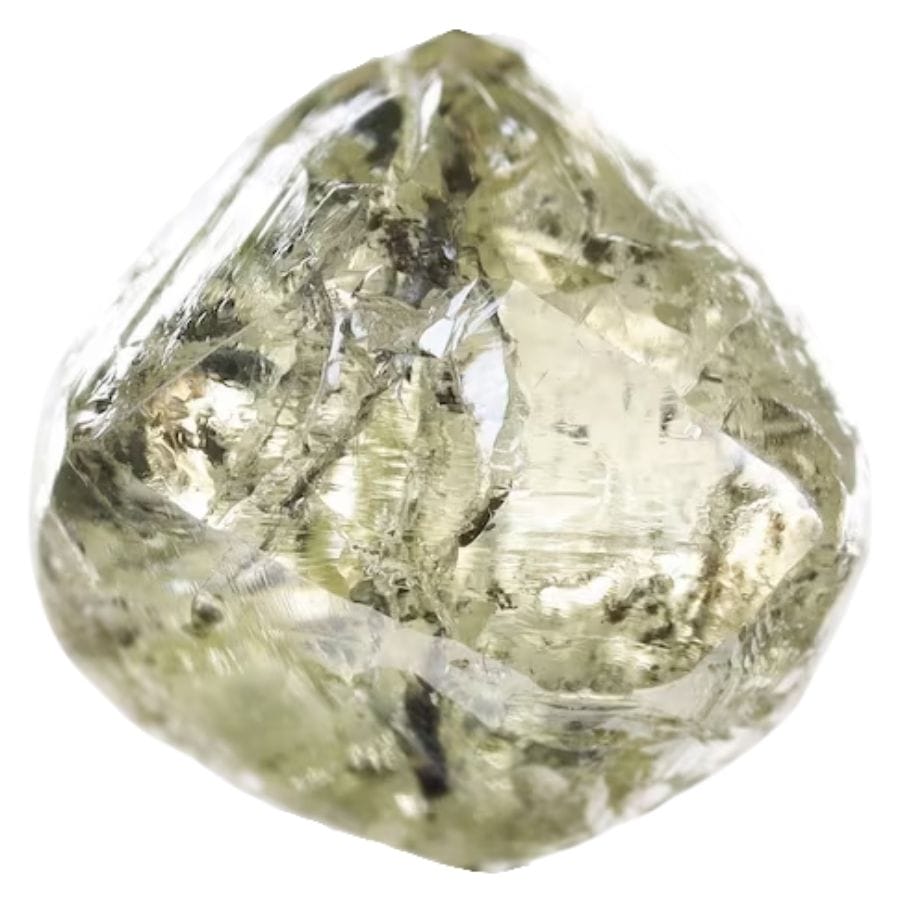
Diamond is a remarkable mineral and although not commonly found, it’s considered one of the most valuable rocks in Wisconsin for those lucky enough to discover it.
This crystal-clear gemstone is made entirely of carbon, one of the most common elements on Earth, but there’s nothing common about diamonds.
They form under extreme conditions of heat and pressure found deep within the Earth’s mantle, over 100 miles beneath the surface. It’s there that carbon atoms are squeezed so tightly together they create the hardest natural substance known to us.
These sparkling gems are brought closer to the Earth’s surface through volcanic eruptions, encased within chunks of rock known as kimberlite.
The journey from the depths of the Earth to accessible locations where they can be mined is long and rare, which is part of what makes diamonds so special.
Once mined, the rough stones are cut and polished to reveal their stunning clarity and brilliance.
Diamonds are highly valued for their unmatched hardness and light-reflecting facets, making them a top choice for jewelry, especially engagement rings.
They’re also used in industrial settings for cutting, grinding, and drilling because they can make short work of almost any material.
Where you can find diamonds in Wisconsin
- Waverley, Pierce County
- Eagle, Waukesha County
- Kenosha, Kenosha County
Garnet
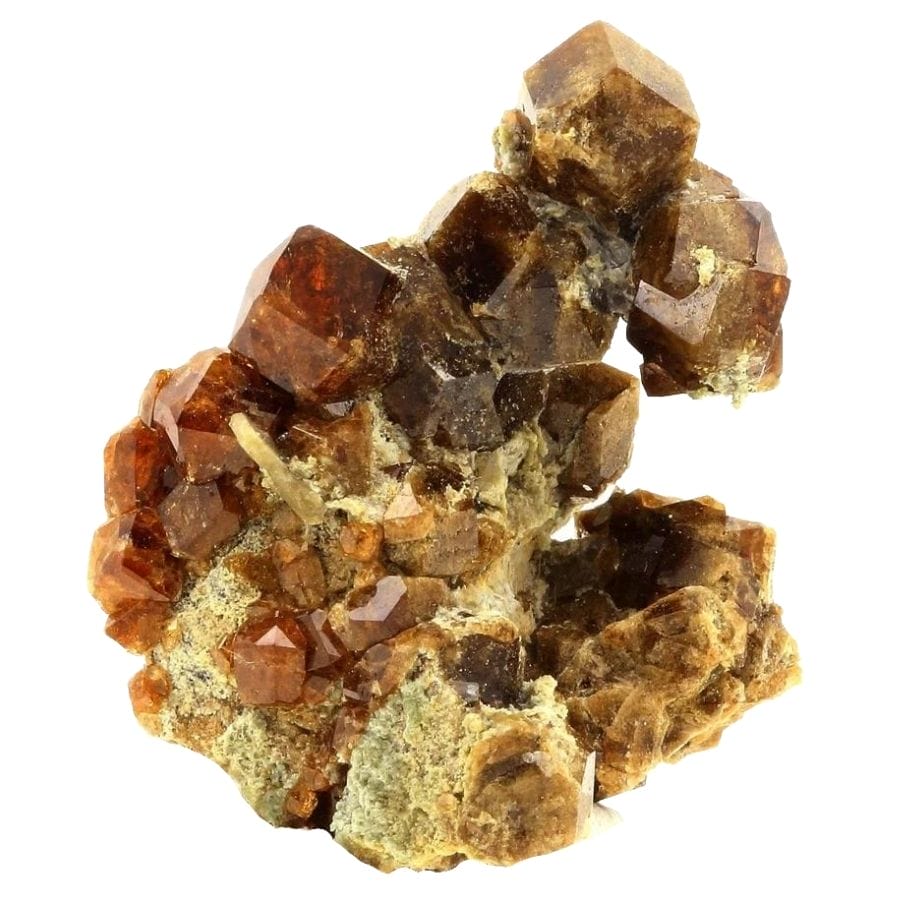
Garnet is a family of minerals that’s known for its beautiful colors and the way it catches light. There are different types of garnet, and in Wisconsin, you can find varieties like almandine, grossular, pyrope, and spessartine.
These garnets form in different ways: some grow in metamorphic rocks, which are rocks that have changed because of heat and pressure inside the Earth, while others can be found in igneous rocks, which are made from cooled lava or magma.
Almandine garnets are typically deep red and are often found in the state’s metamorphic rocks.
Grossular garnets can be colorless, green, yellow, or even reddish-brown and usually form in rocks that have been chemically changed by heat and fluids.
Pyrope garnets, with their deep red color, are formed under the high-pressure conditions of the Earth’s mantle and brought to the surface by geological activity.
Spessartine garnets range from orange to reddish-brown and are found in granite or metamorphic rocks.
People value garnets not just because they’re pretty. They’re also very hard, which makes them great for making abrasive materials like sandpaper. Garnets are used in waterjet cutting too, where they help to cut through metal.
In jewelry, garnets are loved for their rich colors and brilliance, adding elegance to rings, necklaces, and bracelets.
Where you can find garnet in Wisconsin
- Bad River Gorge, Ashland County
- Kenosha, Kenosha County
- Stevens Point, Wood County
Zircon
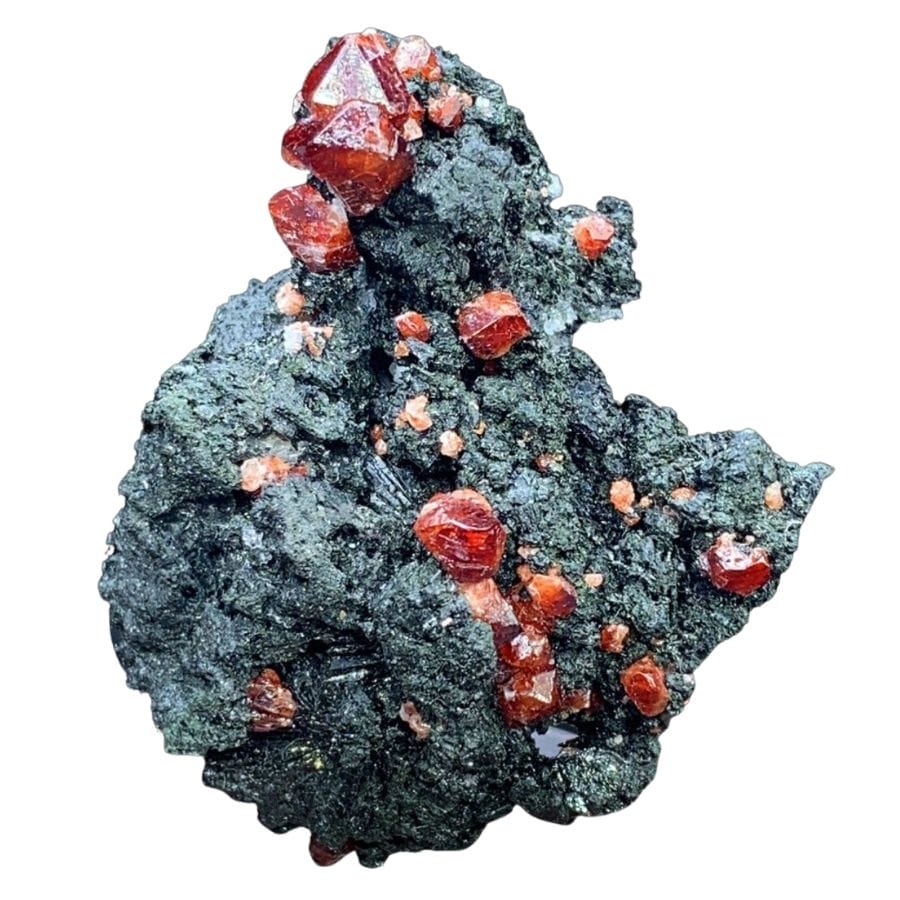
Zircon is a dazzling mineral that’s found in the rocks of Wisconsin, and it’s famous for being the oldest mineral on Earth. This gemstone comes in many colors, from clear to a rainbow of red, blue, yellow, and green shades.
Zircon forms in igneous rocks like granite and in metamorphic rocks like schist. It starts out as molten rock deep beneath the Earth’s surface. As the molten rock cools, zircon crystals start to grow.
Sometimes, they even contain tiny bits of radioactive elements that can be used to date the rocks they are found in.
One of the cool things about zircon is that it can survive geologic events like mountain-building, erosion, and even metamorphism, which can change other minerals a lot.
Because of this, zircon crystals are like time capsules, giving scientists clues about what the Earth was like billions of years ago.
Zircon is not only beautiful and varied in color, but it’s also really tough, which makes it great for jewelry that lasts a long time. It can also stand in for diamonds sometimes because it’s less expensive but still sparkles a lot when it’s cut right.
Where you can find zircon in Wisconsin
- Hamilton Mounds, Adams County
- Mellen, Ashland County
- Wausau, Marathon County
Our Favorite Places For Gem Mining in Wisconsin
With so many great options to choose from in Wisconsin, we wanted to narrow it down for you. Here are our favorite places for gem mining for both adults and children:
Always Confirm Access and Collection Rules!
Before heading out to any of the locations on our list you need to confirm access requirements and collection rules for both public and private locations directly with the location. We haven’t personally verified every location and the access requirements and collection rules often change without notice.
Many of the locations we mention will not allow collecting but are still great places for those who love to find beautiful rocks and minerals in the wild without keeping them. We also can’t guarantee you will find anything in these locations since they are constantly changing.
Always get updated information directly from the source ahead of time to ensure responsible rockhounding. If you want even more current options it’s always a good idea to contact local rock and mineral clubs and groups
Montreal Mine
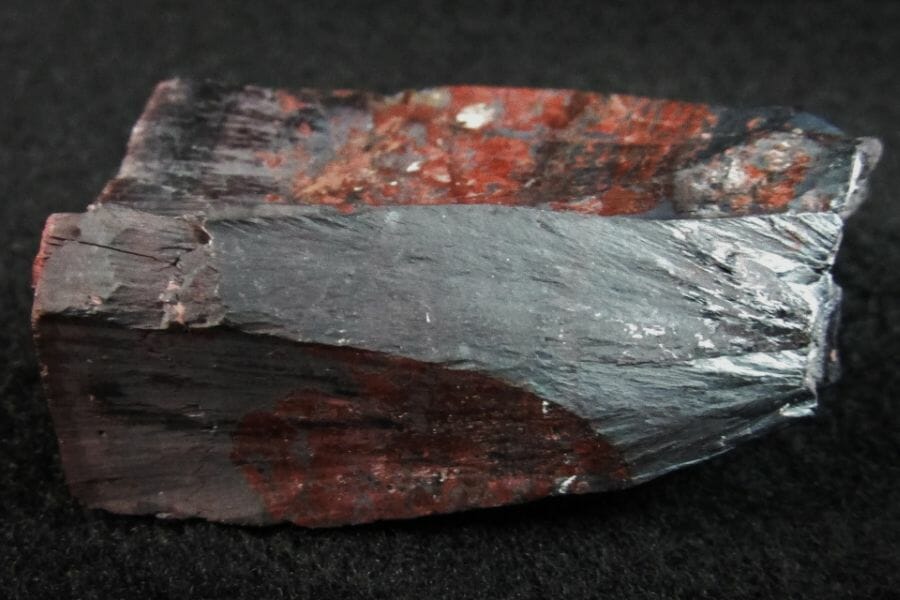
State Road 77 – Montreal, WI 54550
The Montreal Mine is located near Ironwood in Gogebic County. The mine was first opened in 1885 by the Montreal Mining Company, and operated until 1967. During its 82 year history, it produced significant amounts of copper, iron ore and zinc. In 1921, the Montreal Mine became the largest producer of copper in the United States.
Today, the site is a popular tourist attraction with visitors able to explore old mining buildings and machinery that still remain.
The Types of Gems Found In The Montreal Mine
There are many different gems and other things to find including:
- Actinolite
- Barite
- Calcite
- Celestine
- Dolomite
- Gypsum
- Hematite
- Marcasite
- Pyrite
- Quartz
- Rhodochrosite
- Siderite
- Talc
The Best Time To Visit The Montreal Mine
The best time to visit is during the summer months. The temperatures tend to be mild and the days are usually sunny, making it a great time to explore the area and take part in outdoor activities.
If you want REAL results finding incredible rocks and minerals you need one of these 👇👇👇
Finding the coolest rocks in isn’t luck, it's knowing what to look for. Thousands of your fellow rock hunters are already carrying Rock Chasing field guides. Maybe it's time you joined the community.
Lightweight, mud-proof, and packed with clear photos, it’s become the go-to tool for anyone interested discovering what’s hidden under our red dirt and what they've already found.
Join them, and make your next rockhounding trip actually pay off.
What makes it different:
- 📍 Find and identify 140 incredible crystals, rocks, gemstones, minerals, and geodes across the USA
- 🚙 Field-tested across America's rivers, ranchlands, mountains, and roadcuts
- 📘 Heavy duty laminated pages resist dust, sweat, and water
- 🧠 Zero fluff — just clear visuals and straight-to-the-point info
- ⭐ Rated 4.8★ by real collectors who actually use it in the field
Big Bay State Park
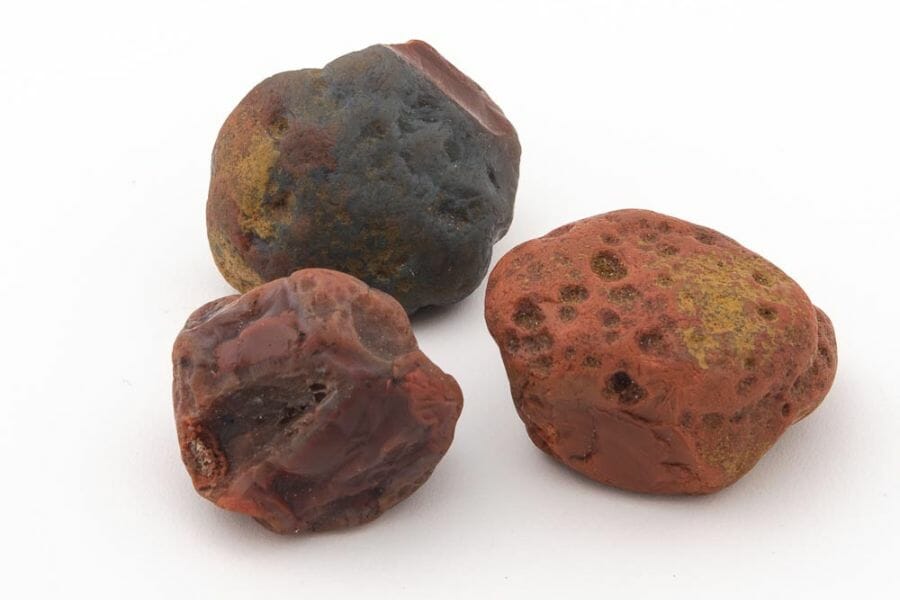
2402 Hagen Rd, La Pointe, WI 54850
Big Bay State Park is located on Madeline Island, the largest of the Apostle Islands in Wisconsin. The park features 8 miles of shoreline on Lake Superior, camping, hiking trails, swimming beaches and bird watching. When you visit here, you might even have a chance to get your hands on some of the prettiest Wisconsin crystals.
The area was first inhabited by Native Americans who used the island for fishing and hunting. After 1855, it became part of the United States and a popular tourist destination. In 1921, Big Bay State Park was established and has been open ever since for visitors to enjoy its natural beauty.
The Types of Gems Found In Big Bay State Park
There are several gems you can keep an eye out for when looking around but this spot is most well known for:
- Superior Agate
- Jasper
The Best Time To Visit Big Bay State Park
The best time to visit Big Bay State Park is during the summer months of June through August. The park offers a variety of activities and attractions aside from hunting for gems, including camping, swimming, hiking, biking, and fishing. During the summer months, temperatures are mild and days are long with plenty of sunshine.
Plum Creek
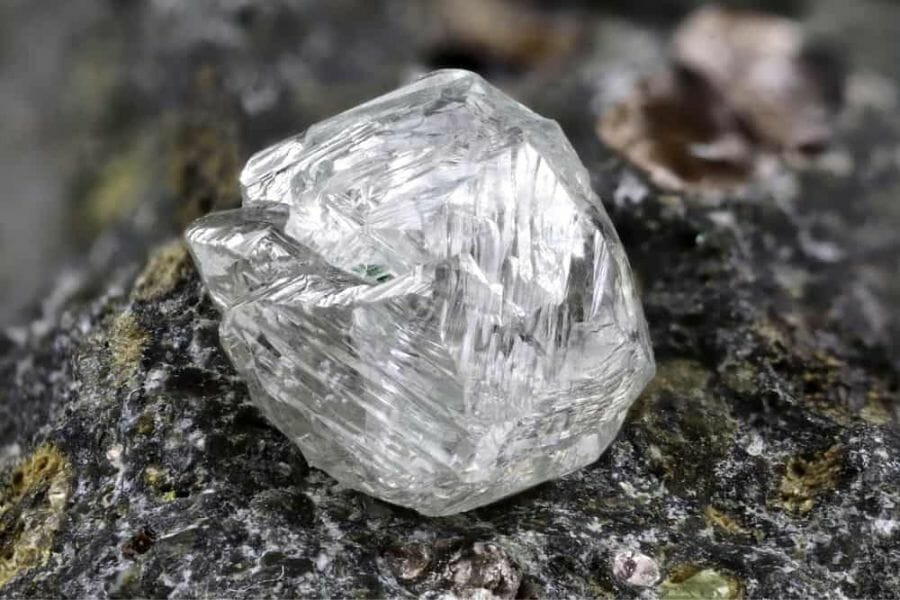
N4351 Co. Rd. HH Plum City, WI 54761
Plum Creek is located in Nugget Lake County Park, a scenic park located in Douglas County. The park is situated on the south shore of Nugget Lake and consists of over 500 acres of wooded land and rolling hills.
Nugget Lake Park has a unique history related to diamond mining. In the late 1800s, prospectors came to the area in search of diamonds. While they never found any significant deposits, they did discover quartz crystals that looked like diamonds. These crystals were known as “nuggets” and became a popular souvenir for visitors to take home. As a result, Nugget Lake County Park was named after these crystals.
The Types of Gems Found In Plum Creek and Nugget Lake Park
You can find a lot of quartz crystals in the park but it is most well-known for being one of the few places in Wisconsin where you can find diamonds.
The Best Time To Visit Plum Creek
The best and most popular time to visit is between May and October. This is because the water levels are usually lower during this time period, making it easier to access the gravel beds that contain gems. Additionally, the warmer weather makes it more pleasant for outdoor activities like gem mining.
Dells Mining Co – Great for kids
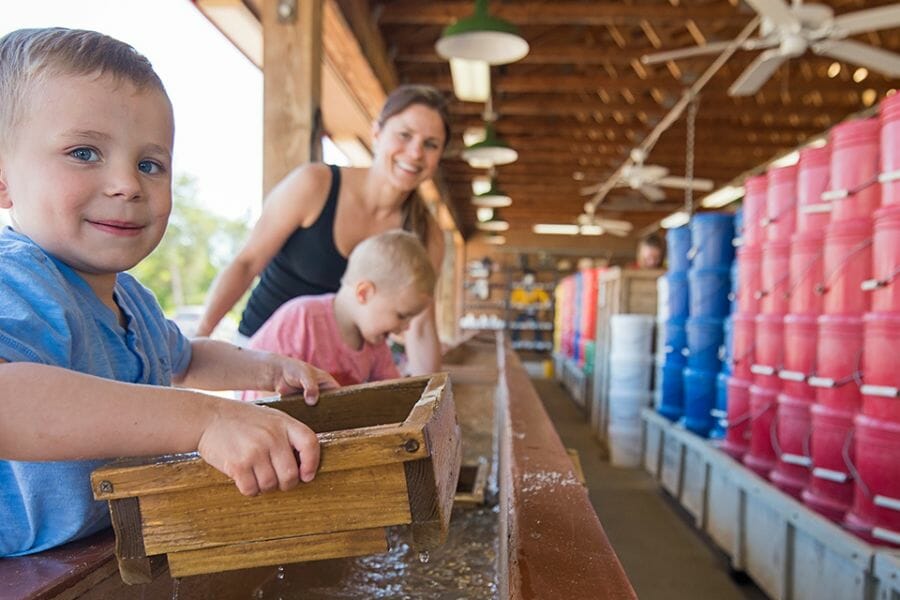
427 Broadway Ave, Wisconsin Dells, WI 53965
Established in 1982, Dell’s Mining Co. offers an exciting and educational experience for all ages! Guests are invited to search through sand for a variety of gems and minerals, including rubies, sapphires, fossils and arrowheads. The knowledgeable staff is always happy to help with suggestions on how to identify the treasures you find.
After your hunt, you can take your gems home or have them set into jewelry at their on-site shop. Dell’s Mining Co. also offers custom gemstone cutting services and rock tumbling supplies so you can make your own jewelry right at home!
The Types Of Gems Found At Dells Mining Co
- Amethyst
- Agate
- Quartz
- Citrine
- Garnet
- Beryl
- Jasper
- Fluorite
The Best Time To Visit Dells Mining Co
The best time to visit Dells Mining Co. is during the summer months, when the weather is warm and sunny and the attractions are open. The peak season runs from May through September, so plan your visit accordingly.
Door County Gem Mining
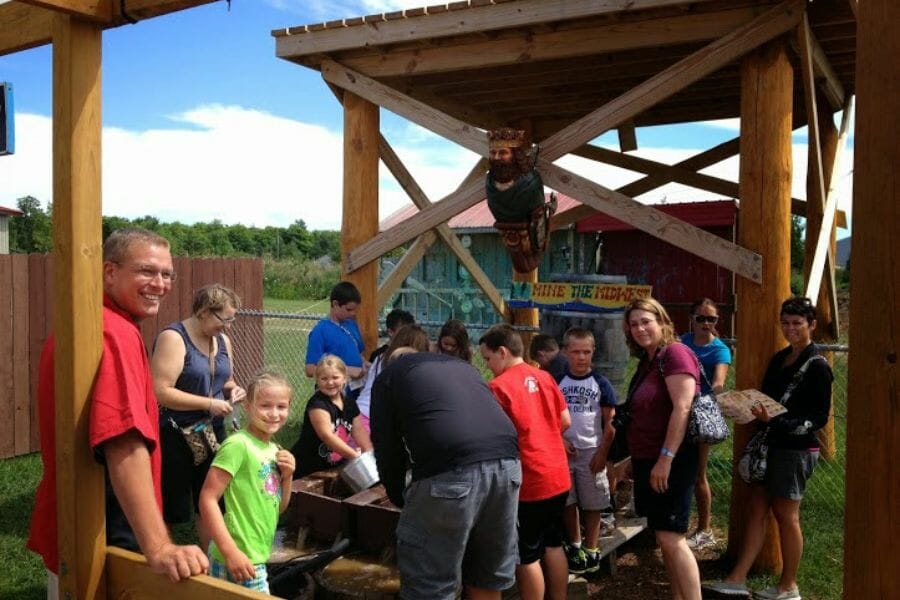
7340 WI-42, Egg Harbor, WI 54209
Door County Gem Mining offers a unique gem mining experience. Visitors can pan for gemstones in the sluice, which is filled with a variety of different gems. They also offer a variety of activities such as gem identification and sorting, jewelry-making classes and more!
The company also sells a variety of rocks, minerals, fossils and other items from their store. It has become a popular tourist attraction for those interested in geology and gem collecting and can be a great option to get kids interested.
The Types Of Gems Found At Door County Gem Mining
Some of the gems that visitors can find include:
- Amethyst
- Calcite
- Fluorite
- Pyrite
- Quartz
The Best Time To Visit Door County Gem Mining
The best time to visit Door County Gem Mining is during the summer months from May to September when the weather is typically warm and sunny. The gem mining season typically runs from mid-May through late October.
Other Great Options For Real Gem Mining in Wisconsin
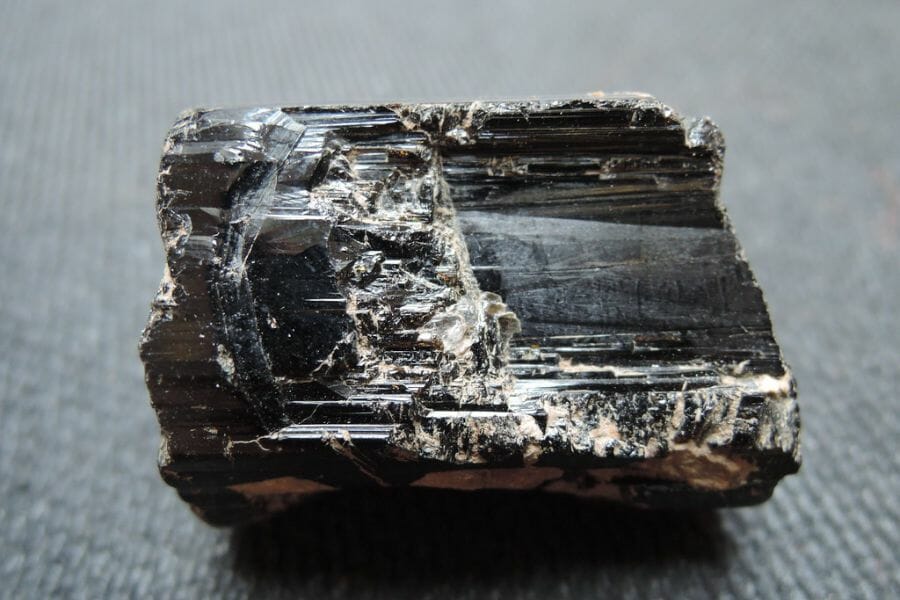
After getting the opportunity to check out our recommended spots above, there are numerous other great locations for real gem mining in Wisconsin. Listed below is a more thorough list of locations where you can discover some fantastic gems. These spots are better suited for adults and those who have some experience gem hunting.
- Ableman’s Gorge – Quartz
- Amnicon River Beach
- The Bend Deposit – azurite, malachite, and pyrite
- Dresser Trap Rock Quarry – actinolite, augite, bornite, calcite, chrysotile, cuprite, epidote, magnetite, quartz, zoisite
- Little Girls Point Beach
- LaSalle Falls – Black Tourmaline
- Necedah Bluff – Quartz
- Pine River – Red Tourmaline
- Plum Creek – Diamonds
- Plummer Mine – Magnetite and Hematite
- Powell – Kyanite
- Rib Mountain – Quartzite
- Quartz Hill – Quartz
- Saxon Harbor Beach
- Stettin – Moonstone
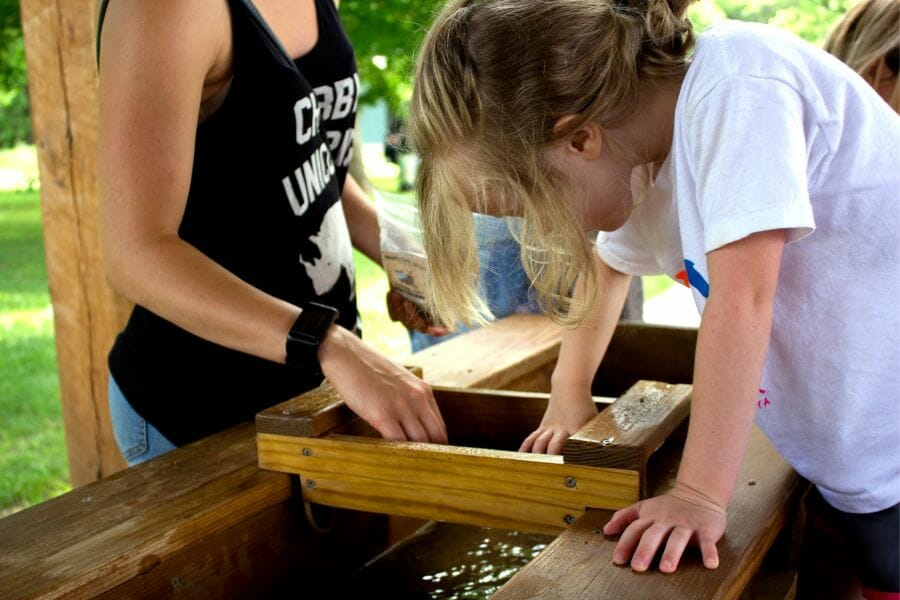
The Top Public Gem Mining Locations in Wisconsin
If you’re looking for some more family-friendly locations, or a way to get your first taste of gem mining there are plenty of options for that as well. Here are some of the better public gem ming locations especially for younger children and families. These aren’t traditional mining but are a great introduction and way to learn about gems and rocks.
- Crystal Cave – W965 WI-29, Spring Valley, WI 54767
- Door County Rock and Gem – 2849 Shannon Ln, Sister Bay, WI 54234
- Pike River Prospecting – N11899 US-141, Wausaukee, WI 54177
Wisconsin Gem Mining Laws And Regulations
Gem hunting regulations are set forth by the Wisconsin Department of Natural Resources (DNR). Generally, gemstones and rocks may be collected from public lands for personal use, with some restrictions.
It is illegal to remove any rocks or minerals from Wisconsin state parks or properties owned by the DNR. It is also illegal to collect gems and minerals in designated wilderness areas or areas that are part of a scientific study.
In addition, it is important to note that rock collecting on private property requires the permission of the landowner. If you plan on collecting gems and minerals on private land, make sure you have obtained written permission from the owner.
For additional information, contact the Wisconsin Department of Natural Resources using the link above.
Additional places to mine for gems in nearby states
If you’ve already tried all of our recommendations above or are planning a trip out of the state you should check out our guides for neighboring states:
- Gem mining in Illinois
- Gem mining in Indiana
- Gem mining in Iowa
- Gem mining in Michigan
- Gem mining in Minnesota
If you have any recommendations we haven’t covered please leave them in the comments below

